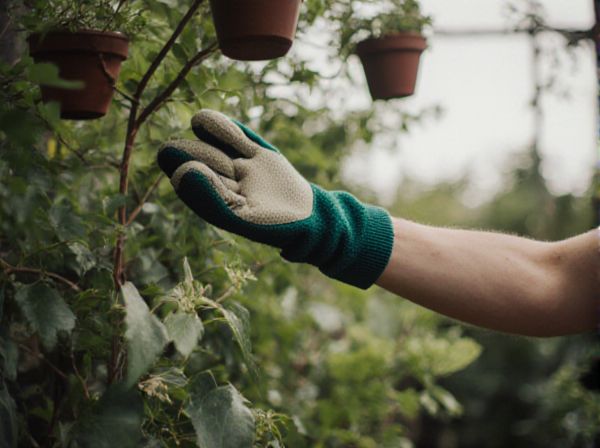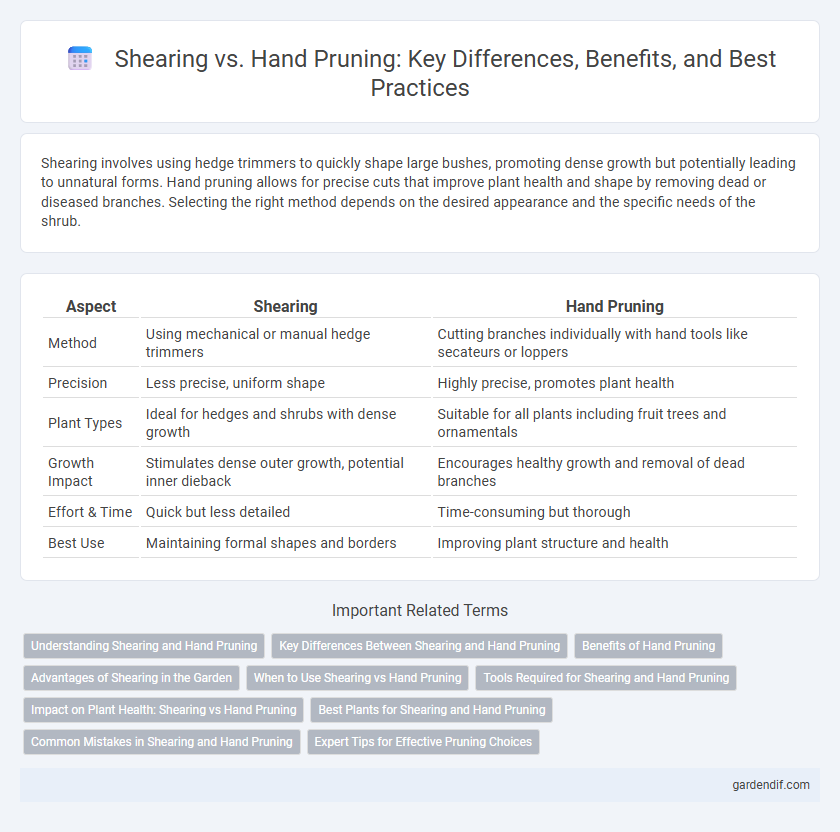
shearing vs hand pruning Illustration
Shearing involves using hedge trimmers to quickly shape large bushes, promoting dense growth but potentially leading to unnatural forms. Hand pruning allows for precise cuts that improve plant health and shape by removing dead or diseased branches. Selecting the right method depends on the desired appearance and the specific needs of the shrub.
Table of Comparison
| Aspect | Shearing | Hand Pruning |
|---|---|---|
| Method | Using mechanical or manual hedge trimmers | Cutting branches individually with hand tools like secateurs or loppers |
| Precision | Less precise, uniform shape | Highly precise, promotes plant health |
| Plant Types | Ideal for hedges and shrubs with dense growth | Suitable for all plants including fruit trees and ornamentals |
| Growth Impact | Stimulates dense outer growth, potential inner dieback | Encourages healthy growth and removal of dead branches |
| Effort & Time | Quick but less detailed | Time-consuming but thorough |
| Best Use | Maintaining formal shapes and borders | Improving plant structure and health |
Understanding Shearing and Hand Pruning
Shearing involves trimming the outer growth of hedges or shrubs uniformly, producing a dense, formal shape often used for decorative purposes. Hand pruning targets specific branches to remove dead or diseased wood, improve plant health, and encourage natural growth patterns and fruit production. Understanding the distinctions between shearing and hand pruning is essential for maintaining plant health and achieving desired landscape aesthetics.
Key Differences Between Shearing and Hand Pruning
Shearing involves uniformly trimming the outer edges of plants to maintain a specific shape, often used for hedges, resulting in dense growth but potentially reducing plant health due to lack of selective cuts. Hand pruning targets individual branches with precise cuts that remove dead, diseased, or crossing limbs, promoting better air circulation, enhanced plant structure, and overall vigor. The key differences lie in shearing's focus on aesthetics and uniformity versus hand pruning's emphasis on plant health and natural growth patterns.
Benefits of Hand Pruning
Hand pruning offers precise control over plant shape and growth by allowing selective removal of specific branches, leading to improved plant health and structure. It minimizes damage to surrounding tissues compared to shearing, reducing the risk of disease and promoting better wound healing. This method encourages natural growth patterns and enhances flowering and fruit production by targeting exact areas that need attention.
Advantages of Shearing in the Garden
Shearing offers rapid shaping and uniform appearance, making it ideal for hedges and topiary designs. This method efficiently trims large areas, reducing labor time compared to hand pruning. Shearing promotes dense growth by cutting multiple shoots simultaneously, enhancing privacy screens and formal garden aesthetics.
When to Use Shearing vs Hand Pruning
Shearing is ideal for maintaining the shape and uniformity of hedges and shrubs, particularly during the active growing season in late spring to early summer. Hand pruning is preferred when precise cuts are needed to remove dead or diseased branches, promote healthy growth, and improve air circulation, especially in late winter or early spring before new growth begins. Choosing the right method depends on the plant species, desired aesthetic, and the timing within the growth cycle.
Tools Required for Shearing and Hand Pruning
Shearing requires hedge trimmers or electric shears specifically designed for uniform cuts across large shrub surfaces, ensuring rapid shaping and maintenance. Hand pruning demands precise tools such as bypass pruners, loppers, and pruning saws that allow selective cutting of branches and stems for better plant health and structure. Proper selection of these tools enhances efficiency, accuracy, and plant vitality in both shearing and hand pruning tasks.
Impact on Plant Health: Shearing vs Hand Pruning
Shearing creates uniform cuts that can lead to rapid leaf growth but often damages the plant's natural structure, increasing susceptibility to pests and diseases. Hand pruning allows for precise removal of dead or diseased branches, promoting better air circulation and overall plant vigor. Proper hand pruning supports long-term health by encouraging strong branch development and reducing stress compared to shearing.
Best Plants for Shearing and Hand Pruning
Shearing is ideal for dense, fast-growing shrubs like boxwood, privet, and yew, where maintaining a uniform shape is crucial. Hand pruning suits plants requiring precision and selective cuts, such as roses, fruit trees, and hydrangeas, to promote healthy growth and flowering. Choosing between shearing and hand pruning depends on the plant's growth habit and desired aesthetic outcome.
Common Mistakes in Shearing and Hand Pruning
Common mistakes in shearing include over-cutting, which damages plant structure and reduces flowering potential, and ignoring natural growth patterns, leading to unnatural shapes. Hand pruning errors often involve improper cut placement that causes branch dieback and the failure to remove diseased or dead wood effectively. Both shearing and hand pruning require precise timing and technique to maintain plant health and promote optimal growth.
Expert Tips for Effective Pruning Choices
Shearing creates uniform shapes but can weaken plants by promoting dense outer growth and restricting airflow, increasing disease risk. Hand pruning allows precise cuts to remove dead or diseased wood, encouraging healthy growth and better shape control. Experts recommend hand pruning for long-term plant health, reserving shearing for rapid aesthetic shaping of hedges.
shearing vs hand pruning Infographic

 gardendif.com
gardendif.com